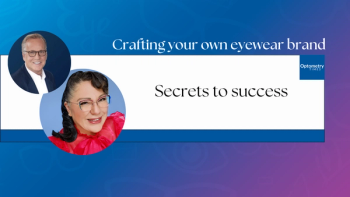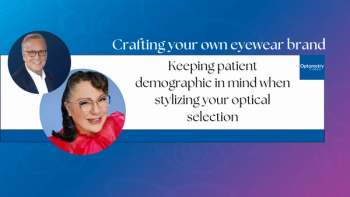
VEW 2024: Insights from The Vision Council
The Vision Council frequently releases research surrounding trends in various facets of the eye care industry, and Vice President of Research and Insights Alysse Henkel shares some highlights of recent reports.
At Vision Expo West 2024 in Las Vegas, Nevada, Alysse Henkel of The Vision Council shared some key takeaways from recent research published by the association. Topics included consumer behavior around eyewear labeled made in the USA, low vision referrals and caregiver research, and practice growth trends for 2024 compared to 2023. Henkel also previewed studies regarding online behavior: Their surveys concluded that patients are more reliant on online reviews to select their eye care provider than they were 2 years ago, that they are more open to receiving an eye exam from a remote provider, and that online eyewear sales have remained steady.
Video transcript
Alysse Henkel:
I'm Alysse Henkel. I'm the Vice President of Research and Insights at The Vision Council, which is a trade or association for the optical industry. So on the market research team at The Vision Council, we develop reports and insights that are of use to our members. And our members come from sort of all over the industry. So we have everything across the supply chain, from folks who manufacture lenses and frames all the way to the eye care practitioners who, you know, do exams or sell eyewear in their offices, and sort of all of the other related eyewear accessories, or over-the-counter products as well, too.
So those are all members of The Vision Council, and the way that we develop our research is that we annually survey our members to find out what topics are sort of bubbling to the top for them and what's of interest for us to research the next year. So we always set our research agenda sort of in the fall, planning for the next year based on what we hear from our members. So sometimes they want us to sort of update research we've done in the past so we can trend it over time, and sometimes we're researching new topics that come up each year. But we do have sort of regular reports, including we do annual market estimates, like how big the industry is, how much are people spending? And then we also do a quarterly Consumer Insights study, because we run a monthly survey, and we roll those numbers up quarterly to tell people, sort of how consumers are behaving related to eyewear and eye care. And then we also have a Provider Insights that we run twice a year where we ask eye care practitioners about what's going on in their practice.
So that we recently ran a survey of US adults this summer and asked them, sort of their feelings about eyewear and just generally, what made in the USA-labeled products mean to them. So we found out that about half of US adults are saying that they're looking for made in the USA products when they go shopping, and overall, so this is not specific to eyewear, but overall, we saw about 47% of folks saying that they would pay a premium of 6% or more for a product labeled made in the USA.
And then when we get specific to eyewear, we're kind of testing whether or not the way that the definition is developed now by the Federal Trade Commission, which is a pretty strict definition for made in the USA products, it means that all, or virtually all, materials that go into the product have to be sourced in the US. So we did some testing about whether or not they felt like, for example, like a factory that designs, manufactures, sort of does all the craftsmanship of a frame in the US, but some of the materials are imported. We asked folks if they considered that product made in the US, and we had about three quarters of American adults say that they would consider that as a made in the USA product. And then overall, we saw, again, a little more than half of consumers saying that they would, for some products, some eyewear products, pay more for a made in the USA label. So in particular, prescription sunglasses and safety eyewear, I think sort of we're at the top of the list of people more likely to pay a little bit more for a label that says made in the USA.
So for the low vision report that we did earlier this year, we had sort of two elements about how we asked people, low vision patients, about what's going on with their diagnosis and sort of their experience as a patient with low vision. We did qualitative focus groups with two groups of low vision patients. So one with people who were low vision patients themselves, and then the other group was with caregivers of people, mostly children, with low vision. And then we also did a survey as follow up. So the focus groups were small, but the survey was large. We had a lot bigger audience for the survey, again, asking both caregivers and patients with low vision about their experience.
What we found was that about two thirds of people who had been diagnosed with a low vision condition said that they got a referral to a specialist. But we're seeing that those who had a more recent diagnosis so within the last 10 years, they're much more likely to have a referral to a specialist, at about 74% compared to people who were diagnosed over 10 years ago, they were less likely to get a referral to a specialist at about 44%. So we're seeing some progress in getting people the care that they need and sort of the specialist attention that a low vision patient warrants, but that's something that we're seeing. And overall, I think important to note for these patients is that they primarily rely on their eye care provider for information about their condition. So we have about 74% of folks saying that they rely primarily on their doctor for information. But the younger patients and like sort of younger caregivers, so patients with children who are sort of small, who have low vision issues, they're much more likely to go online to look for information about their condition.
In our Provider Insights study, which we release twice a year, we survey mostly independent practices to find out sort of what's going on in their practice with their performance. And what we found recently this year as compared to last year, that providers are telling us overall [that] they're having a little bit more of an average year. So last year, we saw, on average in 2023 about 50% of providers saying that their practice revenue was above average or excellent, and that this year, so far, we're only seeing about 30% of folks falling into that same category. So that's a 20 percentage point drop. But really the change we're seeing is that more people are saying that that, overall, the practice this year, the performance is about average. So we're not seeing declines in practices, but not seeing the same kind of growth that people were telling us they were seeing last year. So that's sort of one of the highlights as well is that inflation is still top of mind for a lot of providers, saying that it's affecting their wholesale prices, and they're having to pass that on to some of their consumers. So that's sort of another something that we're keeping our eye on, but fewer practices are saying they're having as many problems as they were last year or the year before, retaining or hiring staff.
So we have an upcoming report that we can give a little preview of. We'll probably publish that sometime early this fall. But what it is is it's a survey of US adults and finding out sort of how they behave or what kind of choices or priorities they make when they're choosing their eye care provider or when they're buying eyewear. And so what's nice about this report is that it's trended from a similar report we did 2 years ago. So we're able to sort of talk about how things have changed over the last 2 years.
And so one thing that we're really interested to see is that when folks are looking at choosing their eye care provider, that we're seeing about a 6%, so six percentage point increase, in people saying that online reviews, so like Zocdoc or Google reviews, are more important now than they were years ago. So we're seeing a little bit more of a reliance on online reviews in terms of choosing your provider.
One of the other kind of notable things that we saw in the survey is asking people about why they have an eye exam, and what we're hearing overall, this was the number one item, both 2 years ago and now, is that people say they want healthy vision, but we're seeing an increase in the number of people who are saying that. So we went from 34% in 2022, to 41% in 2024, so healthy vision is more top of mind for patients as they're coming in for an exam.
One thing we don't have trended, because we asked about this for the first time this year, was about whether or not patients had experienced a telehealth exam. So primarily, we asked if people had gone to an eye care practice and then had a provider join their exam remotely and sort of go through their exam remotely with an assistant in the room. And so we saw surprisingly, 11% of people said they had experienced an exam like that with their eye care provider. So that was a higher number than I would have expected, because primarily, we've been asking people, from the telehealth perspective, if they were at home and then video conferencing with their eye care provider, and we've seen that number be really low for a long time, ranging between 1% and 3%--it was 3% in this most recent survey. But that 11% sort of seeing that remote exam, was interesting to us, especially because we've also been hearing sort of anecdotally from some of our members about how difficult, in some cases, it is to hire optometrists for their practice, especially in more rural or remote areas, and this is one solution that they're looking to and so it looks like patients are experiencing that. We also asked people who haven't had that kind of exam if they would be willing to engage with a remote provider, and about half of participants said they would be willing to have an exam like that.
So one of the things that I think has been surprising of late in our data is that we have run a consumer survey very consistently back to 2022 to sort of track changes over time. And one of the things that we've seen over the last couple of years is that the online purchase rate for eyewear has been really steady. So it's been almost exactly 16% each month, with the exception--because we saw sort of an increase during Covid[-19 pandemic], and then it's ramped down a little bit since 2022. But what we've seen this year is like a 2 or 3 percentage point decrease, so almost like 1 percentage point per quarter so far this year, where fewer people are buying their eyewear online. So I think that's sort of an interesting trend. I think that people often assume the trend is going in the other direction. So, you know, overall, it's still about 1 in 6 eyewear purchases for prescription eyewear are happening online, but really the market is very much still in person. And actually the in-person market is growing a little bit.
Yeah, so I think overall, I just want people to sort of understand the wealth of information that we have at The Vision Council. So not only do we have sort of a research download center on our website, just packed full of reports that are free to our members, but we also have a Foundation website, so thevisioncouncilfoundation.org, where we also publish highlights from some of our research that's available to anyone. So I think that's those are, you know, some takeaways that people can sort of go in and see for themselves about the kind of data that's available. And we're also always looking for people to join our research panel and answer our survey questions at eye care practices about what's going on.
Newsletter
Want more insights like this? Subscribe to Optometry Times and get clinical pearls and practice tips delivered straight to your inbox.


















































.png)


